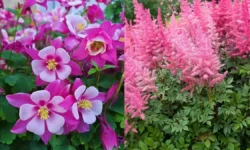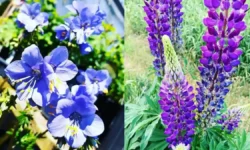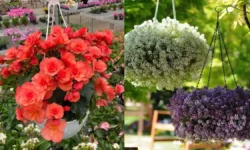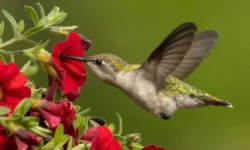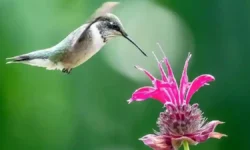The Wandering Jew plant is a favorite among indoor gardeners due to its fast growth, trailing vines, and strikingly colorful leaves. Known for its purple, green, and silvery striped foliage, this plant brings a vibrant and exotic touch to any room. Its cascading stems look beautiful in hanging baskets, on bookshelves, or even as ground cover in warmer outdoor climates. While it is considered an easy-to-care-for houseplant, giving it the right conditions can make the difference between a plant that looks ordinary and one that truly thrives.
In this guide you will find everything you need to know about Wandering Jew plant care: lighting, watering, soil, potential issues, and even propagation of new plants by cutting. Whether you are a beginner or an experienced plant enthusiast, understanding these tips will help you maintain lush and vibrant foliage all year round.
Table of Contents
Understanding the Wandering Jew Plant
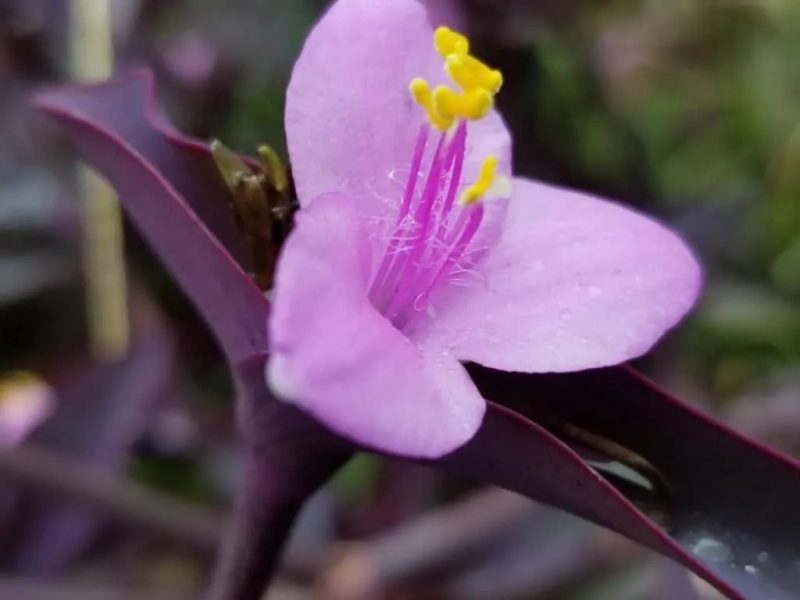
The name Wandering Jew commonly refers to species in the Tradescantia genus, with Tradescantia zebrina and Tradescantia fluminensis being the most popular. Native to tropical and subtropical regions of Central and South America, these plants are perennials that thrive in warm, humid environments. Their rapid growth and spreading habit earned them the name “wandering,” as they can quickly cover large areas if grown outdoors.
The most striking feature of the Wandering Jew plant is its foliage. Leaves vary depending on the variety, but many have bold stripes of purple, silver, and green, creating a shimmering effect when exposed to bright light. The leaves are usually oval-shaped with pointed tips and a slightly fleshy texture, allowing them to retain some moisture. While they do produce small flowers, usually pink, white, or purple, these are secondary to their decorative leaves.
Because of their trailing growth habit, Wandering Jew plants are perfect for hanging baskets, tall planters, or placed on high shelves where their vines can spill over the edges. Outdoors, they can be used as a colorful ground cover, although in some regions they are considered invasive due to their rapid growth.
Light Requirements for Vibrant Foliage
Why Light Matters
Proper lighting is essential for maintaining the vivid colors of Wandering Jew leaves. Bright, indirect sunlight brings out the rich purples and silvers, while low-light conditions often result in dull, greenish foliage. When grown in insufficient light, the plant may also become leggy, stretching toward the nearest light source.
Best Indoor and Outdoor Placement
Indoors, place the plant near a bright window, preferably east- or south-facing, where it can receive at least six hours of indirect light per day. If natural light is limited, a grow light can help maintain its vibrant appearance. Outdoors, especially in USDA zones 9 to 11, choose a spot with partial shade or filtered sunlight. Direct sunlight for long hours can scorch the leaves, causing them to turn brown at the edges.
Adjusting for Seasonal Changes
During winter, natural light levels decrease, which may cause the plant to lose some of its color. Moving it closer to a sunny window or supplementing with artificial light can help. Rotating the plant every one to two weeks ensures that all sides receive even light, promoting balanced growth and preventing one-sided trailing.
Watering the Wandering Jew Properly
Keeping Moisture Balanced
Watering is one of the most important aspects of Wandering Jew plant care. These plants prefer consistently moist soil, but they are highly sensitive to waterlogged conditions. Overwatering can lead to root rot, while underwatering causes the leaves to become dry and crispy, especially at the edges.
Check the soil by inserting your finger about an inch deep; water only when the top layer feels slightly dry. During active growth in spring and summer, watering two or three times a week may be necessary, depending on indoor temperature and humidity.
Seasonal Adjustments
In fall and winter, when the plant’s growth naturally slows, reduce watering frequency. Excessive watering during the dormant period can lead to fungal issues and yellowing leaves. Always empty saucers under pots to avoid standing water.
Choosing the Best Soil Mix
Ideal Soil Composition
The Wandering Jew thrives in a lightweight, well-draining potting mix. A high-quality indoor plant mix enriched with organic matter, combined with a small amount of perlite or coarse sand, provides the perfect balance of drainage and moisture retention. This ensures that roots remain healthy and oxygenated.
Repotting and Soil Refreshing
Repotting every year or two not only gives the plant more space to grow but also replenishes nutrients in the soil. Choose a pot that is slightly larger than the current one and has drainage holes to prevent water accumulation. Refreshing the top layer of soil every few months can also help keep the plant healthy.
Temperature and Humidity Preferences
Warmth for Optimal Growth
The Wandering Jew plant grows best in temperatures between 60°F and 80°F (15°C to 27°C). It does not tolerate frost, and exposure to temperatures below 50°F (10°C) can damage the leaves. If you are growing it outdoors, bring it inside before the first frost.
Humidity for Lush Foliage
High humidity levels help maintain the plant’s vibrant leaves. Although it can tolerate average indoor humidity, dry air may cause leaf tips to brown. Increasing humidity by misting the plant, placing it on a pebble tray, or using a humidifier can significantly improve its appearance.
Fertilizing for Healthy Growth
Feeding Schedule
Regular feeding ensures the Wandering Jew maintains its rich colors and strong growth. Use a balanced, water-soluble houseplant fertilizer diluted to half-strength every two to four weeks during the growing season. Excessive fertilizer can damage roots and lead to weak, overly fast growth, so avoid overfeeding.
Seasonal Feeding Adjustments
Stop fertilizing in fall and winter when the plant’s growth slows naturally. Resume feeding in spring to encourage new, healthy vines.
Pruning and Maintenance
Encouraging Fullness
Pruning is essential to prevent the plant from becoming leggy. Pinching back the growing tips encourages branching, creating a bushier and more compact look. You can also trim long, trailing stems to keep the plant neat.
Removing Old Growth
Regularly removing yellowing or damaged leaves improves air circulation and helps prevent pests. Clean, sharp scissors or pruning shears should always be used to avoid crushing stems.
Propagation by Cuttings
Simple and Quick Method
Propagating the Wandering Jew is easy and fun, making it a great plant to share with friends. Take stem cuttings about 4 to 6 inches long, making sure they include at least one node. Remove the leaves from the lower portion of the cutting.
Rooting Techniques
Place the cuttings in water or directly in moist soil. Roots usually develop in one to two weeks when placed in water, and once they reach a few inches long, they can be transferred to soil. Planting several cuttings together creates a fuller, lusher appearance.
Common Problems and How to Fix Them
Yellowing Leaves
Yellow leaves often indicate overwatering or poor drainage. Reduce watering, check for soggy soil, and repot if necessary.
Brown Leaf Tips
Dry, crispy leaf edges are usually caused by low humidity or underwatering. Increasing humidity and maintaining even soil moisture solves this issue.
Pests
Spider mites and aphids occasionally attack Wandering Jew plants, especially in dry conditions. Wiping leaves with a damp cloth, misting, and using neem oil or insecticidal soap help control infestations.
Display and Decorative Ideas
The cascading vines of the Wandering Jew plant make it perfect for hanging baskets, tall shelves, or decorative pots. Its striking foliage adds contrast when grouped with green or variegated houseplants. Outdoors, it can be used as a colorful ground cover, but regular trimming is necessary to control its vigorous growth.
FAQs about Wandering Jew Plant Care
What Is the Best Light for Wandering Jew Plants?
Wandering Jew plants thrive in bright, indirect sunlight. Too little light will make the leaves lose their vibrant purple and silver tones, while direct sunlight can scorch the foliage. An east- or south-facing window is ideal for indoor growing.
How Often Should I Water a Wandering Jew Plant?
Water when the top inch of soil feels slightly dry. Keep the soil evenly moist but never soggy, as overwatering can cause root rot. Reduce watering in fall and winter when the plant’s growth slows.
What Soil Is Best for Wandering Jew Plants?
A well-draining, nutrient-rich potting mix is perfect. Mixing standard indoor plant soil with perlite or coarse sand improves drainage and keeps the roots healthy.
Does a Wandering Jew Plant Need High Humidity?
Yes, higher humidity levels help maintain lush foliage and prevent brown leaf tips. Misting the leaves or placing the pot on a pebble tray with water can increase indoor humidity.
How Do I Make My Wandering Jew Fuller?
Pruning or pinching back the growing tips encourages branching, resulting in a bushier plant. Regularly trimming long, leggy vines keeps the plant compact and attractive.
Can Wandering Jew Plants Be Grown Outdoors?
Yes, in USDA zones 9 to 11, they can be grown outdoors as ground cover or in hanging baskets. However, in some areas, they may spread aggressively, so regular trimming is recommended.
How Do I Propagate a Wandering Jew Plant?
Take 4- to 6-inch stem cuttings, remove the lower leaves, and place the cuttings in water or moist soil. Roots usually develop in one to two weeks, and planting several cuttings together creates a fuller pot.
Why Are My Wandering Jew Leaves Turning Yellow?
Yellowing leaves often indicate overwatering or poor drainage. Check the soil moisture and ensure the pot has proper drainage holes. Repotting in fresh, well-draining soil can help revive the plant.
Why Are the Leaf Tips Turning Brown?
Brown, crispy tips are typically caused by low humidity or underwatering. Increasing humidity and maintaining consistent moisture can restore healthy foliage.
Are Wandering Jew Plants Safe for Pets?
No, Wandering Jew plants are toxic to cats and dogs if ingested, causing skin irritation or digestive upset. Keep them out of reach of pets.
Final Thoughts
The Wandering Jew plant is a stunning, fast-growing houseplant that rewards you with lush, vibrant foliage when cared for properly. Providing bright indirect light, evenly moist soil, and regular pruning will keep it looking its best. Propagation is simple, making it easy to expand your collection or share with others. With the right care, your Wandering Jew will remain healthy, colorful, and a true highlight in any indoor garden.

